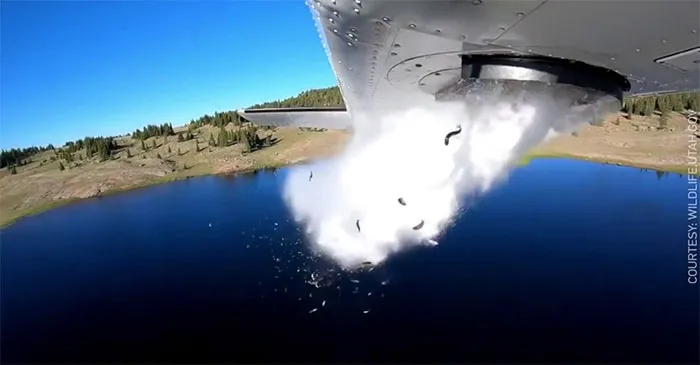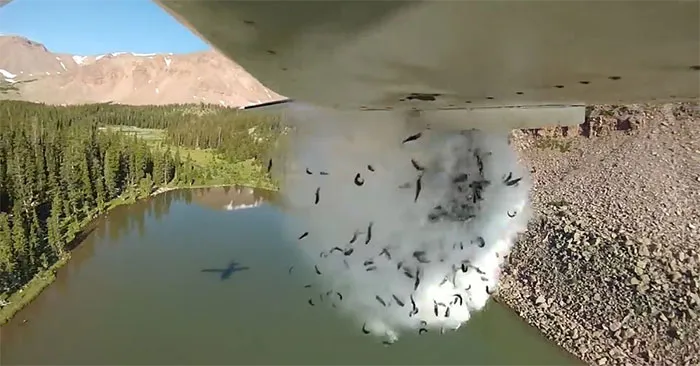Utah, a state celebrated for its majestic mountains and pristine lakes, offers exceptional fishing experiences. However, unbeknownst to many, Utah employs a unique and fascinating method to maintain its abundant fish population: aerial fish stocking, creating the astonishing phenomenon of “fish rain.”
Join Discovery To Wonders as we explore Utah’s hidden streams, where you can witness breathtaking natural landscapes and the unparalleled “fish rain”—a testament to human ingenuity and dedication to nature conservation.
“Fish Rain”: A Unique Solution for Remote Lakes
To ensure a thriving fish supply for visitors, the Utah Division of Wildlife Resources (DWR) devised an innovative solution: stocking fish from airplanes. Annually, tens of thousands of juvenile fish are released into mountain lakes inaccessible by road.
This method saves considerable time and effort and remarkably ensures a high survival rate for the fish. These small fish, only a few inches long, gently “rain” down onto the water’s surface, their descent cushioned by air resistance, preventing harsh impact.


The History of Aerial Fish Stocking
Aerial fish stocking isn’t a novel concept. This method has been used in several U.S. states since the 1950s. However, Utah is among the most effective and large-scale practitioners.
Historically, transporting fish to remote lakes was a significant challenge. Methods included horse-drawn carts, trucks, and even manually carrying fish. However, with advancements in technology, airplanes became the ideal solution for delivering fish to inaccessible locations.
How Does Fish Stocking Work?
The fish stocking process is meticulously planned and scientifically executed. Fish are raised in hatcheries and then transported to airports in large tanks. Each flight can carry hundreds of gallons of water and tens of thousands of fish.
Upon reaching the designated location, technicians open valves, and the fish are released to fall freely into the lake. Air resistance slows their descent, ensuring a safe water entry. The survival rate for air-dropped fish is typically very high, ranging from 95% to 99%.
Which Secret Utah Streams Experience “Fish Rain”?
“Fish rain” doesn’t occur in every Utah lake. It’s usually limited to high-elevation lakes in mountainous regions, where ground transportation is difficult. Notable locations include:
- Fish Lake: Situated in Fishlake National Forest, this lake is a perfect destination for fishing enthusiasts and nature lovers.
- Mirror Lake: Located in the Uinta Mountains, Mirror Lake is renowned for its pristine beauty and crystal-clear waters.
- Thousand Lake Mountain: This high-elevation plateau features thousands of small lakes, creating a unique and breathtaking landscape.
To witness “fish rain,” contact the Utah Division of Wildlife Resources for information on stocking schedules and locations.


The Impact of Drought on Utah’s Fish Population
Recent severe droughts have significantly impacted Utah’s fish populations. Many rivers and lakes have dried up, making fish restocking more challenging. Local authorities have relaxed some regulations to prevent mass fish die-offs due to rising temperatures.
However, thanks to the efforts of authorities and the community, Utah’s fish populations remain relatively stable. “Fish rain” continues, delighting visitors and contributing to the biodiversity conservation of this region.
Utah: More Than Just “Fish Rain”
Utah offers more than just “fish rain”; it’s a captivating tourist destination with numerous exciting activities. You can:
- Visit National Parks: Zion, Bryce Canyon, Arches, and Canyonlands are famous national parks with stunning landscapes and incredible hiking trails.
- Ski in Winter: Utah is a premier skiing destination in North America, boasting numerous world-class resorts.
- Explore Salt Lake City: Utah’s capital is a modern city with museums, theaters, and cultural attractions.
Conclusion
Utah’s hidden streams are not only places of scenic beauty but also the stage for the extraordinary “fish rain,” a testament to human innovation and dedication to nature preservation. If you visit Utah, don’t miss the chance to discover these wonders. What do you think about this unique approach to fish conservation? Share your thoughts in the comments below!